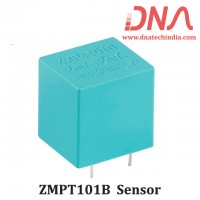|
|
Differential Amplifier
|
|
|
|
|
|
Thus far we have used only one of the operational amplifiers inputs to connect to the amplifier, using either the "inverting" or the "non-inverting" input terminal to amplify a single input signal with the other input being connected to ground. But we can also connect signals to both of the inputs at the same time producing another common type of operational amplifier circuit called a Differential Amplifier. |
|
|
Basically, as we saw in the first tutorial about operational amplifiers, all op-amps are "Differential Amplifiers" due to their input configuration. But by connecting one voltage signal onto one input terminal and another voltage signal onto the other input terminal the resultant output voltage will be proportional to the "Difference" between the two input voltage signals of V1 and V2. |
|
|
Then differential amplifiers amplify the difference between two voltages making this type of operational amplifier circuit a Subtractor unlike a summing amplifier which adds or sums together the input voltages. This type of operational amplifier circuit is commonly known as a Differential Amplifier configuration and is shown below: |
|
|
|
|
|
Differential Amplifier
|
|
|

|
|
|
By connecting each input inturn to 0v ground we can use superposition to solve for the output voltage Vout. Then the transfer function for a Differential Amplifier circuit is given as:
|
|
|

|
|
|
When resistors, R1 = R2 and R3 = R4 the above transfer function for the differential amplifier can be simplified to the following expression: |
|
|
|
|
|
Differential Amplifier Equation
|
|
|

|
|
|
If all the resistors are all of the same ohmic value, that is: R1 = R2 = R3 = R4 then the circuit will become a Unity Gain Differential Amplifier and the voltage gain of the amplifier will be exactly one or unity. Then the output expression would simply be Vout = V2 - V1. Also note that if input V1 is higher than input V2 the ouput voltage sum will be negative, and if V2 is higher than V1, the output voltage sum will be positive. |
|
|
The Differential Amplifier circuit is a very useful op-amp circuit and by adding more resistors in parallel with the input resistors R1 and R3, the resultant circuit can be made to either "Add" or "Subtract" the voltages applied to their respective inputs. One of the most common ways of doing this is to connect a "Resistive Bridge" commonly called a Wheatstone Bridge to the input of the amplifier as shown below.
|
|
|
Bridge Amplifier
|
|
|

|
|
|
The standard Differential Amplifier circuit now becomes a differential voltage comparator by "Comparing" one input voltage to the other. For example, by connecting one input to a fixed voltage reference set up on one leg of the resistive bridge network and the other to either a "Thermistor" or a "Light Dependant Resistor" the amplifier circuit can be used to detect either low or high levels of temperature or light as the output voltage becomes a linear function of the changes in the active leg of the resistive bridge and this is demonstrated below. |
|
|
|
|
|
Light Activated Switch
|
|
|

|
|
|
Here the circuit above acts as a light-activated switch which turns the output relay either "ON" or "OFF" as the light level detected by the LDR resistor exceeds or falls below a pre-set value at V2 determined by the position of VR1. A fixed voltage reference is applied to the inverting input terminal V1 via the R1 - R2 voltage divider network and the variable voltage (proportional to the light level) applied to the non-inverting input terminal V2. It is also possible to detect temperature using this type of circuit by simply replacing the Light Dependant Resistor (LDR) with a thermistor. By interchanging the positions of VR1 and the LDR, the circuit can be used to detect either light or dark, or heat or cold using a thermistor. |
|
|
One major limitation of this type of amplifier design is that its input impedances are lower compared to that of other operational amplifier configurations, for example, a non-inverting (single-ended input) amplifier. Each input voltage source has to drive current through an input resistance, which has less overall impedance than that of the op-amps input alone. This may be good for a low impedance source such as the bridge circuit above, but not so good for a high impedance source. |
|
|
One way to overcome this problem is to add a Unity Gain Buffer Amplifier such as the voltage follower seen in the previous tutorial to each input resistor. This then gives us a differential amplifier circuit with very high input impedance and low output impedance as it consists of two non-inverting buffers and one differential amplifier. This then forms the basis for most "Instrumentation Amplifiers". |
|
|
|
|
|
Instrumentation Amplifier
|
|
|
Instrumentation Amplifiers (in-amps) are very high gain differential amplifiers which have a high input impedance and a single ended output. Instrumentation amplifiers are mainly used to amplify very small differential signals from strain gauges, thermocouples or current sensing devices in motor control systems.
|
|
|
Unlike standard operational amplifiers in which their closed-loop gain is determined by an external resistive feedback connected between their output terminal and one input terminal, either positive or negative, "instrumentation amplifiers" have an internal feedback resistor that is effectively isolated from its input terminals as the input signal is applied across two differential inputs, V1 and V2. |
|
|
The instrumentation amplifier also has a very good common mode rejection ratio, CMRR (zero output when V1 = V2) well in excess of 100dB at DC. A typical example of a three op-amp instrumentation amplifier with a high input impedance ( Zin ) is given below: |
|
|
|
|
|
High Input Impedance Instrumentation Amplifier
|
|
|

|
|
|
The two non-inverting amplifiers form a differential input stage acting as buffer amplifiers with a gain of 1 + 2R2/R1 for differential input signals and unity gain for common mode input signals. Since amplifiers A1 and A2 are closed loop negative feedback amplifiers, we can expect the voltage at Va to be equal to the input voltage V1. Likewise, the voltage at Vb to be equal to the value at V2. |
|
|
As the op-amps take no current at their input terminals (virtual earth), the same current must flow through the three resistor network of R2, R1 and R2 connected across the op-amp outputs. This means then that the voltage on the upper end of R1 will be equal to V1 and the voltage at the lower end of R1 to be equal to V2. This produces a voltage drop across resistor R1 which is equal to the voltage difference between inputs V1 and V2, the differential input voltage, because the voltage at the summing junction of each amplifier, Va and Vb is equal to the voltage applied to its positive inputs. |
|
|
However, if a common-mode voltage is applied to the amplifiers inputs, the voltages on each side of R1 will be equal, and no current will flow through this resistor. Since no current flows through R1 (nor, therefore, through both R2 resistors, amplifiers A1 and A2 will operate as unity-gain followers (buffers). Since the input voltage at the outputs of amplifiers A1 and A2 appears differentially across the three resistor network, the differential gain of the circuit can be varied by just changing the value of R1. |
|
|
The voltage output from the differential op-amp A3 acting as a subtractor, is simply the difference between its two inputs ( V2 - V1 ) and which is amplified by the gain of A3 which may be one, unity, (assuming that R3 = R4). Then we have a general expression for overall voltage gain of the instrumentation amplifier circuit as: |
|
|
|
|
|
Instrumentation Amplifier Equation
|
|
|

|
|
|
In the next tutorial about Operational Amplifiers, we will examine the effect of the output voltage, Vout when the feedback resistor is replaced with a frequency dependant reactance in the form of a capacitance. The addition of this feedback capacitance produces a non-linear operational amplifier circuit called an Integrating Amplifier. |
|
|
|
|
|
Reproduced with permission from Wayne Storr |
|
|
http://www.electronics-tutorials.ws/opamp/opamp_5.html |










